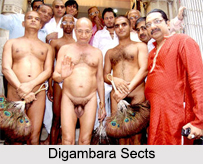 Digambara Sect is a major sect of Jainism, also known as "Digvasanas". They wear no clothes following the practice of Lord Mahavira. In Sanskrit language the term "Digambara" means "sky clad". The native Jain communities of Maharashtra, Madhya Pradesh and Uttar Pradesh, Karnataka, Tamil Nadu are all Digambaras. Digambara also has different communities under it such as Saitwal, Lad, Khandelwal, Bagherwal and Agarwal.
Digambara Sect is a major sect of Jainism, also known as "Digvasanas". They wear no clothes following the practice of Lord Mahavira. In Sanskrit language the term "Digambara" means "sky clad". The native Jain communities of Maharashtra, Madhya Pradesh and Uttar Pradesh, Karnataka, Tamil Nadu are all Digambaras. Digambara also has different communities under it such as Saitwal, Lad, Khandelwal, Bagherwal and Agarwal.
Religious Practices of Digambara Sect
The Digambar monks do not consider themselves to be nude but consider themselves wearing the environment. Digambaras believe that by discarding clothes they have been able to refuse to give in to the body"s demand for comfort. They have only two possessions, a peacock feather broom to clear their path of insects to avoid trampling them and a water gourd to drink water. They beg their food and eat only once a day. They carry the alms they receive in cupped hands. A Digambara monk eats in standing posture from the hollow of his hands. The standing posture is prescribed because if a monk cannot stand anymore due to old age or illness the body is to be discarded by fasting till death called as "Sallekhana". For eating or drinking he does not use any pots or pans. He eats the prescribed vegetarian food without any preference.
The holiest Digambara site is Shravanabelagola, where there is the 57 foot high image of Bahubali, also known as "Gomateshwar". He was the youngest of the one hundred sons of the first Tirthankara, Lord Rishabha and king of Podanpur. The Digambaras believe he is the first person in the world to achieve liberation. The Digambaras do not generally touch the image in a temple and a priest called "upadhye" carries out pujas and the worship is simple with flowers and jewellery rarely being used. Therefore Digambaras follow a very pious, disciplined life away from the pleasures of worldly, material life.
Sub-Sects of Digambaras
The present Digambara-Jains are divided into a larger number of sects. The two most important Digambara-sects of today are the Viswapanthis and the Terapanthis. Viswapanthis are in great numbers in Maharashtra and Gujarat and Terapanthis outnumber in Rajputana, in Uttar Pradesh and Madhya Pradesh.
Viswapanthis recognize Bhattarakas as spiritual leaders. They install images of Ksetrapalas, of Gods like Bhairava, etc. in their temples, cover the idols with Saffron and embellish them with flowers; offer them sweets, worship them with gifts in the night and wave lights in front of them. Terapanthis do not accept any Bhattarakas, do not install images of Ksetrapalas, do not offer flowers or sweets to the idols, do not apply saffron to them, do not worship them in the night with offerings and lights, but restrict themselves to reciting Aratrika-Patha. The Viswapanthis worship in sitting position and Terapanthis in standing position; Terapanthis sit only when they count the pearls of their rosaries while gently uttering the mantras.
Other Digambara-sects of the present-day are Taranapanthis. Their community was founded by Taranaswami. They are hostile to the idols, but worship the 14 books of their founder (Granthas) by keeping them on the altar.




















